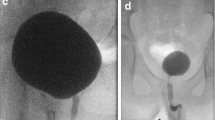Abstract
Background
The risks associated with radiation exposure are higher in children than in adults. Therefore the use of fluoroscopy in common pediatric examinations such as voiding cystourethrography (VCUG) requires accurate determination of the associated effective dose.
Objective
To estimate effective dose for VCUG examinations performed in children younger than 10 years using anthropomorphic phantoms and metal oxide semiconductor field-effect transistor (MOSFET) dosimeters.
Materials and methods
MOSFETs were placed within four phantoms representing children ≤10 years old, at locations corresponding to radiosensitive organs, and exposed to a mock VCUG (5 min of fluoroscopy, 50 spot exposures) to minimize measurement error. Effective dose was measured and scaled to a standardized clinical VCUG (1 min fluoroscopy, 5 spot exposures) determined from patient logs. Monte Carlo simulations were performed to assess the accuracy of the measured effective dose. The dose area product (DAP) from each VCUG was compared to the effective dose.
Results
Effective doses ranged from 0.10 to 0.55 mSv, increased with age, and were higher in girls. Fluoroscopy accounted for 88–90% of the total effective dose, and spot exposures 10–12%. MOSFET-measured and simulation-derived effective doses were comparable (T > 0.12). DAP was strongly correlated with effective dose for both genders (r 2>0.97, P < 0.0001).
Conclusion
Effective doses for VCUG examinations performed in children ≤10 years of age are low but not negligible.



Similar content being viewed by others
References
Schneider K, Kruger-Stollfub I, Ernst G (2001) Paediatric fluoroscopy – a survey of children’s hospitals in Europe. Pediatr Radiol 31:238–246
ICRP (1991) 1990 Recommendations of the International Commission on Radiological Protection. Publication 60. Annals of the ICRP 21(1-3). Pergamon, Oxford
Hernandez RJ, Goodsitt MM (1996) Reduction of radiation dose in pediatric patients using pulsed fluoroscopy. AJR 167:1247–1253
Chapple CL, Broadhead D, Faulkner K (1995) A phantom based method for deriving typical patient doses from measurements of dose area product on populations of patients. Br J Radiol 68:1083–1086
Almen A, Mattsson S (1995) The radiation dose to children from x-ray examinations of the pelvis and urinary tract. Br J Radiol 68:604–613
Sulieman A, Theodorou K, Vlychou M et al (2007) Radiation dose measurement and risk estimation for paediatric patients undergoing micturating cystourethrography. Br J Radiol 80:731–737
Perisinakis K, Raissaki M, Damilakis J et al (2006) Fluoroscopy-controlled voiding cystourethrography in infants and children: are the radiation risks trivial? Eur Radiol 16:846–851
Fotakis M, Molybda-Athanasopulou E, Psarrakos K et al (2003) Radiation doses to pediatric patients up to 5 years of age undergoing micturating cystourethrography examinations and its dependence on patient age: a Monte Carlo study. Br J Radiol 76:812–817
Jaffe TA, Gaca AM, Delaney S et al (2007) Radiation doses from small-bowel follow-through and abdominopelvic MDCT in Crohn’s disease. AJR 189:1015–1022
Gaca AM, Jaffe TA, Delaney S et al (2008) Radiation doses from small-bowel follow-through and abdomen/pelvis MDCT in pediatric Crohn disease. Pediatr Radiol 38:285–291
Glennie D, Connolly BL, Gordon CL (2008) Entrance skin dose measured with MOSFETs in children undergoing interventional radiography procedures. Pediatr Radiol 38:1180–1187
Hurwitz LM, Yoshizumi T, Goodman P et al (2007) Effective dose determination using an anthropomorphic phantom and metal oxide semiconductor field effect transistor technology for clinical adult body multidetector computed tomography protocols. J Comput Assist Tomogr 31:544–549
Yoshizumi TT, Goodman PC, Frush DP et al (2007) Validation of metal oxide semiconductor field effect transistor technology for organ dose assessment during CT: comparison with thermoluminescent dosimetry. AJR 188:1332–1336
National Research Council (2006) Health risks of exposure to low levels of ionizing radiation: BEIR VII. National Academies Press, Washington DC
Hiorns MP, Saini A, Marsden PJ (2006) A review of current local dose-area product levels for paediatric fluoroscopy in a tertiary referral centre compared with national standards. Why are they so different? Br J Radiol 79:326–330
Agrawalla S, Pearce R, Goodman TR (2004) How to perform the perfect voiding cystourethrography. Pediatr Radiol 34:114–119
Schultz FW, Geleijns J, Holscher HC et al (1999) Radiation burden to paediatric patients due to micturating cystourethrography examinations in a Dutch children’s hospital. Br J Radiol 72:763–772
Christy M, Eckerman KF (1987) Specific absorbed dose fractions of energy at various ages from internal photon sources. Appendix A: description of the mathematical phantoms. ORNL/TM-8381/VI. Oak Ridge National Laboratory, Oak Ridge, TN
Varchena V, Gubatova DJ, Sidorin V (1993) Children’s heterogeneous phantoms and their application in roentgenology. Radiat Prot Dosim 49:77–78
Varchena V (2002) Pediatric phantoms. Pediatr Radiol 32:280–284
Servomaa A, Tapiovaara M (1998) Organ dose calculation in medical x ray examinations by the program PCXMC. Radiat Prot Dosim 80:213–219
Hart D, Hillier MC, Walls BF (2002) Doses to patients from medical x-ray examinations in the UK – 2000 review. NRPB-W14. National Radiation Protection Board, Chilton, UK
Hart D, Hillier MC, Jones DG (2007) Doses to patients from radiographic and fluoroscopic x-ray imaging procedures in the UK – 2005 review. HPA-RPD-029. Health Protection Agency, Chilton, UK
Chapple CL, Faulkner K, Lee RE et al (1992) Results of a survey of doses to paediatric patients undergoing common radiological examinations. Br J Radiol 65:225–231
Hart D, Jones DG, Wall BF (1996) Estimation of effective doses from pediatric x-ray examinations. NRPB-R279. National Radiological Protection Board, Chilton, UK
Brenner D (2002) Estimating cancer risks from pediatric CT: going from the qualitative to the quantitative. Pediatr Radiol 32:228–231
Hall EJ (2002) Lessons we have learned from our children: cancer risks from diagnostic radiology. Pediatr Radiol 32:700–706
Brenner D, Elliston C, Hall E et al (2001) Estimated risks of radiation-induced fatal cancer from pediatric CT. AJR 176:289–296
Author information
Authors and Affiliations
Corresponding author
Rights and permissions
About this article
Cite this article
Lee, R., Thomas, K.E., Connolly, B.L. et al. Effective dose estimation for pediatric voiding cystourethrography using an anthropomorphic phantom set and metal oxide semiconductor field-effect transistor (MOSFET) technology. Pediatr Radiol 39, 608–615 (2009). https://doi.org/10.1007/s00247-009-1161-5
Received:
Revised:
Accepted:
Published:
Issue Date:
DOI: https://doi.org/10.1007/s00247-009-1161-5




